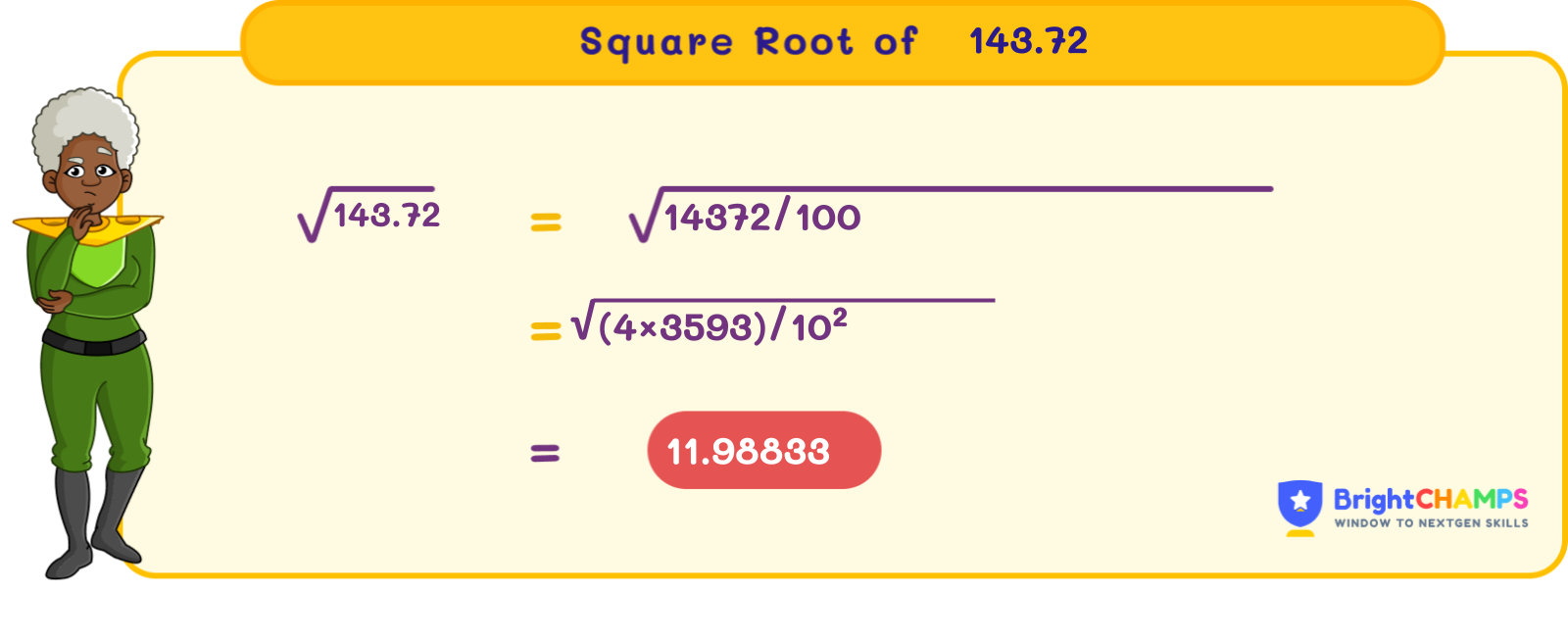![]() Table Of Contents
Table Of Contents

 100 Learners
100 LearnersLast updated on April 28th, 2025

Square Root of 143.72

If a number is multiplied by the same number, the result is a square. The inverse of the square is a square root. The square root is used in the field of vehicle design, finance, etc. Here, we will discuss the square root of 143.72.
What is the Square Root of 143.72?
The square root is the inverse of the square of the number. 143.72 is not a perfect square. The square root of 143.72 is expressed in both radical and exponential forms. In the radical form, it is expressed as √143.72, whereas (143.72)(1/2) in the exponential form. √143.72 ≈ 11.9883, which is an irrational number because it cannot be expressed in the form of p/q, where p and q are integers and q ≠ 0.

Finding the Square Root of 143.72
The prime factorization method is used for perfect square numbers. However, the prime factorization method is not used for non-perfect square numbers where the long division method and approximation method are used. Let us now learn the following methods:
- Prime factorization method
- Long division method
- Approximation method
Square Root of 143.72 by Prime Factorization Method
Prime factorization is not applicable for non-perfect squares like 143.72, as it involves decimals and does not yield a simple expression using integers. For non-perfect squares, we rely on numerical methods such as the long division or approximation method instead.
Square Root of 143.72 by Long Division Method
The long division method is particularly used for non-perfect square numbers. In this method, we should check the closest perfect square number for the given number. Let us now learn how to find the square root using the long division method, step by step:
Step 1: To begin with, we need to group the numbers from right to left. For 143.72, consider it as 14372 (ignoring the decimal temporarily).
Step 2: Find the largest integer n such that n^2 is less than or equal to 143. The integer is 11 because 11^2 = 121, which is less than 143. Subtract 121 from 143 to get a remainder of 22.
Step 3: Bring down 72 to make the dividend 2272. Double the quotient (11) to get 22, which becomes part of our new divisor.
Step 4: Find n such that (220 + n) * n is less than or equal to 2272. Using n = 9, we get (220 + 9) * 9 = 2079.
Step 5: Subtract 2079 from 2272 to get a remainder of 193, and the quotient becomes 11.9.
Step 6: To continue, add decimal places and bring down pairs of zeroes. Repeat the process to reach the desired precision.
The square root of √143.72 is approximately 11.9883.
Square Root of 143.72 by Approximation Method
The approximation method is another method for finding square roots. It is an easy way to estimate the square root of a given number. Now let us learn how to find the square root of 143.72 using the approximation method.
Step 1: Identify the closest perfect squares around 143.72. The closest perfect square below 143.72 is 121 (√121 = 11), and the one above is 144 (√144 = 12).
Step 2: Using linear approximation, estimate where 143.72 falls between these perfect squares.
Step 3: The formula for linear approximation is: (143.72 - 121) / (144 - 121) = (22.72) / 23 ≈ 0.9878
Step 4: Add this result to 11 (the square root of the lower perfect square). Therefore, the approximate square root is 11 + 0.9878 ≈ 11.9878.
So, the square root of 143.72 is approximately 11.9883.

Common Mistakes and How to Avoid Them in the Square Root of 143.72

Square Root of 143.72 Examples

Problem 1
Can you help Max find the area of a square box if its side length is given as √143.72?

Explanation

Problem 2
A square-shaped garden measuring 143.72 square meters is built; if each of the sides is √143.72, what will be the square meters of half of the garden?

Explanation

Problem 3
Calculate √143.72 × 5.

Explanation

Problem 4
What will be the square root of (143.72 + 6.28)?

Explanation

Problem 5
Find the perimeter of the rectangle if its length ‘l’ is √143.72 units and the width ‘w’ is 38 units.

Explanation


FAQ on Square Root of 143.72
1.What is √143.72 in its simplest form?
2.Mention the factors of 143.72.
3.Calculate the square of 143.72.
4.Is 143.72 a prime number?
5.143.72 is divisible by?
Important Glossaries for the Square Root of 143.72
- Square root: A square root is the inverse of a square. For example, 4^2 = 16, and the inverse of the square is the square root, that is √16 = 4.
- Irrational number: An irrational number is a number that cannot be written in the form of p/q, where q is not equal to zero and p and q are integers.
- Principal square root: A number has both positive and negative square roots; however, it is always the positive square root that is used in real-world applications, known as the principal square root.
- Decimal: If a number has a whole number and a fraction in a single number, then it is called a decimal. For example, 7.86, 8.65, and 9.42 are decimals.
- Long division method: A step-by-step process used to divide numbers and find square roots for non-perfect squares, involving grouping and approximating.
Explore More algebra
 Previous to Square Root of 143.72
Previous to Square Root of 143.72


Jaskaran Singh Saluja
About the Author
Jaskaran Singh Saluja is a math wizard with nearly three years of experience as a math teacher. His expertise is in algebra, so he can make algebra classes interesting by turning tricky equations into simple puzzles.

Fun Fact
: He loves to play the quiz with kids through algebra to make kids love it.




